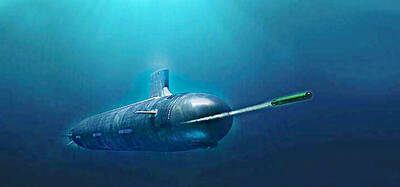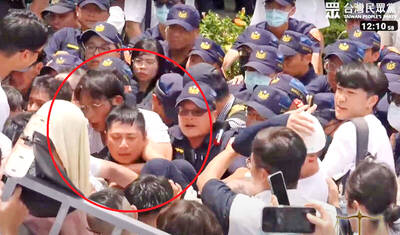China has based its new anti-ship Dong Feng-21D (DF-21D) “carrier killer” missiles along the coast facing Taiwan, US Defense Intelligence Agency Director Michael Flynn said in testimony before the US Senate Armed Services Committee.
Flynn said that Beijing was enhancing the firepower of the more than 1,200 conventional short-range ballistic missiles deployed opposite Taiwan with a limited, but growing, number of conventionally armed, medium-range ballistic missiles, including the DF-21D.
“China is developing a tiered ballistic missile defense system and has successfully tested the upper-tier capability on two occasions,” he said.
Flynn said that China’s People’s Liberation Army (PLA) was building a modern military capable of defending China’s “core interests” of protecting territorial integrity, including Taiwan.
“Preparation for a Taiwan conflict with US intervention remains the primary driver of the PLA’s evolving force structure, weapons development, operational planning and training,” Flynn said, adding that “China has spent as much as US$215 billion on military-related goods and services in 2012, in contrast to the US$107 billion Beijing reported in its official military budget.”
“Even as the Chinese military plans for conflict and continues its build-up across from Taiwan, cross-strait relations have remained good following President Ma Ying-jeou’s (馬英九) re-election,” he added.
Flynn said the PLA Navy was also developing a JIN-class nuclear-powered ballistic missile submarine and JL-2 submarine-launched missiles.
He said that China’s investment in naval weapons is focused primarily on anti-air and anti-surface capabilities to achieve periodic and local sea and air superiority.
Flynn said that the Chinese air force was transforming from a force oriented solely toward territorial defense into one capable of both offshore offensive and defensive roles, including strike, air and missile defense, as well as early warning and reconnaissance.
While Flynn did not say why China had deployed the new “carrier-killer” missiles opposite Taiwan, Pentagon sources said it was a clear warning to the US to stay well clear of the area in case of a conflict.
However, a report published earlier this month by Ronald O’Rourke, the Congressional Research Service’s specialist in naval affairs, said the missile could be defeated with a combination of active and passive measures along its “kill chain.”
O’Rourke said the US Navy could reduce the aircraft carrier electromagnetic emissions used by the missile and even release false emissions to fool it. In addition, the US Navy could disable the missile’s targeting systems, destroy it in flight or use decoys to confuse it as it approached its target, he added.

FIREPOWER: On top of the torpedoes, the military would procure Kestrel II anti-tank weapons systems to replace aging license-produced M72 LAW launchers Taiwan is to receive US-made Mark 48 torpedoes and training simulators over the next three years, following delays that hampered the navy’s operational readiness, the Ministry of National Defense’s latest budget proposal showed. The navy next year would acquire four training simulator systems for the torpedoes and take receipt of 14 torpedoes in 2027 and 10 torpedoes in 2028, the ministry said in its budget for the next fiscal year. The torpedoes would almost certainly be utilized in the navy’s two upgraded Chien Lung-class submarines and the indigenously developed Hai Kun, should the attack sub successfully reach operational status. US President Donald Trump

TPP RALLY: The clashes occurred near the Chiang Kai-shek Memorial Hall on Saturday at a rally to mark the anniversary of a raid on former TPP chairman Ko Wen-je People who clashed with police at a Taiwan People’s Party (TPP) rally in Taipei on Saturday would be referred to prosecutors for investigation, said the Ministry of the Interior, which oversees the National Police Agency. Taipei police had collected evidence of obstruction of public officials and coercion by “disorderly” demonstrators, as well as contraventions of the Assembly and Parade Act (集會遊行法), the ministry said in a statement on Sunday. It added that amid the “severe pushing and jostling” by some demonstrators, eight police officers were injured, including one who was sent to hospital after losing consciousness, allegedly due to heat stroke. The Taipei

NO LIVERPOOL TRIP: Taiwan’s Lin Yu-ting, who won a gold medal in the boxing at the Paris Olympics, was embroiled in controversy about her gender at that event Taiwanese boxer Lin Yu-ting (林郁婷) will not attend this year’s World Boxing Championships in Liverpool, England, due to a lack of response regarding her sex tests from the organizer, World Boxing. The national boxing association on Monday said that it had submitted all required tests to World Boxing, but had not received a response as of Monday, the departure day for the championships. It said the decision for Lin to skip the championships was made to protect its athletes, ensuring they would not travel to the UK without a guarantee of participation. Lin, who won a gold medal in the women’s 57kg boxing

The US has revoked Taiwan Semiconductor Manufacturing Co’s (TSMC, 台積電) authorization to freely ship essential gear to its main Chinese chipmaking base, potentially curtailing its production capabilities at that older-generation facility. American officials recently informed TSMC of their decision to end the Taiwanese chipmaker’s so-called validated end user (VEU) status for its Nanjing site. The action mirrors steps the US took to revoke VEU designations for China facilities owned by Samsung Electronics Co and SK Hynix Inc. The waivers are set to expire in about four months. “TSMC has received notification from the US Government that our VEU authorization for TSMC Nanjing